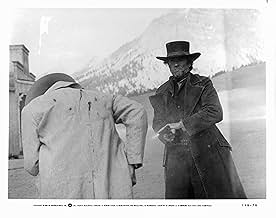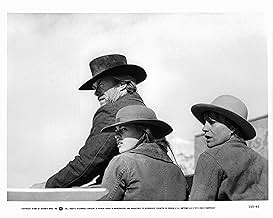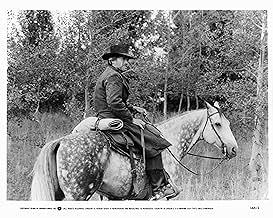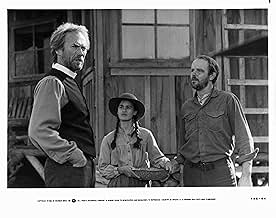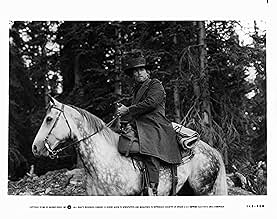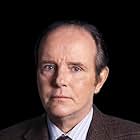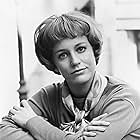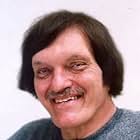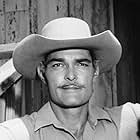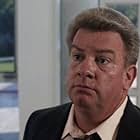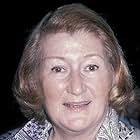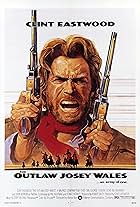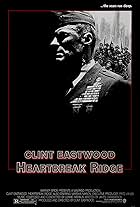A mysterious preacher protects a humble prospector village from a greedy mining company trying to encroach on their land.A mysterious preacher protects a humble prospector village from a greedy mining company trying to encroach on their land.A mysterious preacher protects a humble prospector village from a greedy mining company trying to encroach on their land.
- Awards
- 2 wins & 2 nominations
Chris Penn
- Josh LaHood
- (as Christopher Penn)
Chuck Lafont
- Eddie Conway
- (as Chuck LaFont)
Randy Oglesby
- Elam
- (as Tom Oglesby)
- Director
- Writers
- All cast & crew
- Production, box office & more at IMDbPro
Storyline
Did you know
- TriviaDuring shooting, Clint Eastwood sustained what he describes as the worst injury he has ever had on-set when a horse he was riding fell through thin ice and launched him forward. Clint suffered a dislocated shoulder.
- GoofsWhen the Preacher throws a bucket of water over McGill to stop him lighting the wagon on fire, the amount of steam coming from McGill's clothes indicates it is obviously warm water, but the only water the Preacher could've gotten from outside was the cold water from the horse trough. The water also entirely misses the flaming match, which remains lit.
Unless the trough was topped up with hot water to prevent freezing.
- Quotes
Megan Wheeler: [Reading from the Book of Revelation] And when he had opened the fourth seal, I heard the fourth beast said: "Come and see." And I looked, and behold a pale horse. And his name that sat on him was Death.
[the Preacher rides up on his pale horse]
Megan Wheeler: And Hell followed with him.
- Crazy creditsThe credit for catering just says "The Caterers" (including the quotation marks in the credit).
- Alternate versionsAnother version of the 1984 Warner Bros. logo that appeared in the 1990's VHS prints does not have the word "presents" appearing underneath the Warner Communications byline.
Featured review
The Westerns is what gained Eastwood mainstream recognition, and he returns to prosperous grounds with this movie. Much like his character, he returns the Western from the dead and avenges their loss of appeal at the box office. A few years later, he was to strike gold with Unforgiven' and although this story is not as gripping as Unforgiven', it is well crafted with minor flaws.
The similarities between this movie and his well-known Spaghetti Westerns are vast, but the difference lies with the superior quality. Once again he is the Man With No Name' defending the weak and settling an old score. Where this one differs from his earlier work is that the characters and dialogue are realistic surpassing the one dimension norm for the genre. The characters are credible in the sense that each has believable motivations for their actions. The Hood are motivated by their greed and the gold miners are motivated by their dreams. The credibility is thus intact with regards to the characters drives meaning that we now do not have to rely on suspension of disbelief as we witness the action unfold. The dialogue is in sync with each character. The Hood speaks with an educated tongue, but his desperation is apparent as the Preacher stands his ground. The miners speak with little sophistication thus reflecting their social status of the times. The Preacher speaks as we would expect The Man With No Name' to speak. He is cool and rational and what little is said carries a lot of weight. The dialogue thus enhances the rich diversity of characters.
Of special note is the casting. All the actors are well suited to their roles. Stockburn and his deputies are particularly memorable. The deputies look like they are all recruits from Hollywood B type action movies. This by no means understates their significance. Instead of playing their usual outlandish bad guys, they relied on their natural ability to exude devilish intent. They look cold, dark and menacing. There was no dialogue which accentuated their malevolence - talk did not interest them. They were there to do a job and small talk was meaningless. Their movements were slow and methodical thus adding to their character's coldness and creating tension as the harbinger's of death prepared to deal out their own brand of justice the kind of justice that only dollars can buy. Although the screen time dedicated to these characters was limited, their impact was far greater.
The casting of Stockburn as a Lee van Cleef look alike was also very good. This could be construed as a lack of originality, but it was ideal for the story. He looks like a weathered, tough baddie, much in line with the impression we have of those times as provided by Hollywood, who had dealt with many situations such as these with a cool, ruthless hand. His dialogue, with assistance from a menacing voice, mirrors his appearance hard and to the point.
Eastwood is the archetypal Man With No Name'. His natural coolness forms the basis for the character. He has the ability to limit his dialogue and communicate to the audience with the assistance of minimal body language the emotions of his character. The sharpening of a glare was all he needed to show that he was a man with a past who could be dangerous. This was vital to the character since it helped create the enigmatic figure that the Preacher was supposed to be.
An indication of the craft of the movie is the scene where the Preacher starts to help his freind break the rock. The rock became an obstacle that they would have to overcome and they began to realise that if they pulled together, not only could they beat the rock, but the Hood as well. Scenes such as this elevated this movie beyond the Spaghetti Western. Attention had been paid to the story and gratuitous action was obviously never the intention. This is not to say that the movie lacked action, it means that action scenes were an integral part of the story and not as eye candy offerings for a hormone charged audience.
As well crafted as it is, it is not without flaws. The first is the scenes within the town. It is easy to tell that the town is a small set for the movie due to the camera angles. This became particularly evident when the Hood is trying to bribe the Preacher with an offer of a church in a rich town. This immediately draws attention to the shots within the town which thus highlights the flaw. I have not checked to see whether this is a consequence of a low budget, which would be feasible since Westerns were not as bankable at that time as they were in the past. Even with due consideration of this fact, the cinematographer could still have made more creative use of camera angles to negate this limiting factor.
A more minor flaw is the how the character of Megan is used in the movie. The book has her name in the title which is indicative of the fact that the story is told through her eyes. The telling of a story through the eyes of a young innocent can add various dimensions to the story. The adventures that unfolds before her would have a greater impact on the audience since the struggles of a child will touch the audience more than that of an adults. People always sympathise for the young. It can add complexity to the story since a child's emotions and pre conceptions will create more opportunity for conflict. There was effort made in this direction, but I feel that if Megan had been given more opportunity to tell the story from her perspective, the story would have been more emotive appeal.
Westerns will always have an audience, although their popularity may fluctuate over time. The lawlessness of the times set the stage for good storytelling and unfortunately also poor storytelling. In the past, they concentrated on a Hollywood B style movie with characters existing as an excuse to pull a trigger in the outlawed West. This formula worked for a while, but the stories lacked the substance to withstand the test of time. This has led to the present situation where the few that have now been on offer have shown an increase in quality. This is probably due to the fact that the limitation in audience appeal has meant that the story has to be of solid value in order to attract the investors. As with all genres, they have actors that are naturally adept to the role. Eastwood was such a man for the Westerns. We now wait for his successor to carry on the legacy of The Man With No Name'.
The similarities between this movie and his well-known Spaghetti Westerns are vast, but the difference lies with the superior quality. Once again he is the Man With No Name' defending the weak and settling an old score. Where this one differs from his earlier work is that the characters and dialogue are realistic surpassing the one dimension norm for the genre. The characters are credible in the sense that each has believable motivations for their actions. The Hood are motivated by their greed and the gold miners are motivated by their dreams. The credibility is thus intact with regards to the characters drives meaning that we now do not have to rely on suspension of disbelief as we witness the action unfold. The dialogue is in sync with each character. The Hood speaks with an educated tongue, but his desperation is apparent as the Preacher stands his ground. The miners speak with little sophistication thus reflecting their social status of the times. The Preacher speaks as we would expect The Man With No Name' to speak. He is cool and rational and what little is said carries a lot of weight. The dialogue thus enhances the rich diversity of characters.
Of special note is the casting. All the actors are well suited to their roles. Stockburn and his deputies are particularly memorable. The deputies look like they are all recruits from Hollywood B type action movies. This by no means understates their significance. Instead of playing their usual outlandish bad guys, they relied on their natural ability to exude devilish intent. They look cold, dark and menacing. There was no dialogue which accentuated their malevolence - talk did not interest them. They were there to do a job and small talk was meaningless. Their movements were slow and methodical thus adding to their character's coldness and creating tension as the harbinger's of death prepared to deal out their own brand of justice the kind of justice that only dollars can buy. Although the screen time dedicated to these characters was limited, their impact was far greater.
The casting of Stockburn as a Lee van Cleef look alike was also very good. This could be construed as a lack of originality, but it was ideal for the story. He looks like a weathered, tough baddie, much in line with the impression we have of those times as provided by Hollywood, who had dealt with many situations such as these with a cool, ruthless hand. His dialogue, with assistance from a menacing voice, mirrors his appearance hard and to the point.
Eastwood is the archetypal Man With No Name'. His natural coolness forms the basis for the character. He has the ability to limit his dialogue and communicate to the audience with the assistance of minimal body language the emotions of his character. The sharpening of a glare was all he needed to show that he was a man with a past who could be dangerous. This was vital to the character since it helped create the enigmatic figure that the Preacher was supposed to be.
An indication of the craft of the movie is the scene where the Preacher starts to help his freind break the rock. The rock became an obstacle that they would have to overcome and they began to realise that if they pulled together, not only could they beat the rock, but the Hood as well. Scenes such as this elevated this movie beyond the Spaghetti Western. Attention had been paid to the story and gratuitous action was obviously never the intention. This is not to say that the movie lacked action, it means that action scenes were an integral part of the story and not as eye candy offerings for a hormone charged audience.
As well crafted as it is, it is not without flaws. The first is the scenes within the town. It is easy to tell that the town is a small set for the movie due to the camera angles. This became particularly evident when the Hood is trying to bribe the Preacher with an offer of a church in a rich town. This immediately draws attention to the shots within the town which thus highlights the flaw. I have not checked to see whether this is a consequence of a low budget, which would be feasible since Westerns were not as bankable at that time as they were in the past. Even with due consideration of this fact, the cinematographer could still have made more creative use of camera angles to negate this limiting factor.
A more minor flaw is the how the character of Megan is used in the movie. The book has her name in the title which is indicative of the fact that the story is told through her eyes. The telling of a story through the eyes of a young innocent can add various dimensions to the story. The adventures that unfolds before her would have a greater impact on the audience since the struggles of a child will touch the audience more than that of an adults. People always sympathise for the young. It can add complexity to the story since a child's emotions and pre conceptions will create more opportunity for conflict. There was effort made in this direction, but I feel that if Megan had been given more opportunity to tell the story from her perspective, the story would have been more emotive appeal.
Westerns will always have an audience, although their popularity may fluctuate over time. The lawlessness of the times set the stage for good storytelling and unfortunately also poor storytelling. In the past, they concentrated on a Hollywood B style movie with characters existing as an excuse to pull a trigger in the outlawed West. This formula worked for a while, but the stories lacked the substance to withstand the test of time. This has led to the present situation where the few that have now been on offer have shown an increase in quality. This is probably due to the fact that the limitation in audience appeal has meant that the story has to be of solid value in order to attract the investors. As with all genres, they have actors that are naturally adept to the role. Eastwood was such a man for the Westerns. We now wait for his successor to carry on the legacy of The Man With No Name'.
Details
Box office
- Budget
- $6,900,000 (estimated)
- Gross US & Canada
- $41,410,568
- Opening weekend US & Canada
- $9,119,111
- Jun 30, 1985
- Gross worldwide
- $41,410,568
- Runtime1 hour 55 minutes
- Color
- Sound mix
- Aspect ratio
- 2.39 : 1
Contribute to this page
Suggest an edit or add missing content



